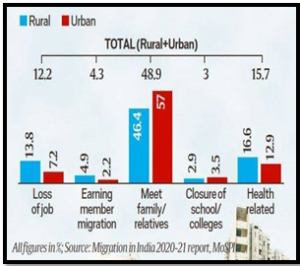A BLURRED MAPPING OF INTERNAL FEMALE MIGRATION
Syllabus:
- GS 1 : Issues related to Women and Migration.
Focus:
- Internal migration is a crucial aspect of India’s socio-economic dynamics, yet the focus often remains on male migrants, sidelining the experiences of women.
- The Periodic Labour Force Survey (PLFS) estimates internal migration at 27% from June 2020 to 2021, highlighting its significance.
- This editorial delves into the challenges and complexities surrounding internal female migration in India and the need for tailored policy interventions.
Source: IE
Migration in India Report 2020-21:
- Released by Ministry of Statistics and Program Implementation in June 2022.
- Recorded 0.7% of the population as ‘temporary visitors’ during July 2020-June 2021.
- Temporary visitors defined as those staying continuously for 15 days or more but less than 6 months after March 2020.
- Over 84% of temporary visitors moved due to the pandemic.
- All-India migration rate:9% (July 2020-June 2021).
- Rural migration rate:5%, Urban migration rate: 34.9%.
- Females recorded a higher migration rate (47.9%) compared to males (10.7%).
- Female rural migration rate: 48%, Female urban migration rate: 47.8%.
- Male rural migration rate: 5.9%, Male urban migration rate: 22.5%.
- 8% of females migrated for marriage, while 49.6% of males migrated for employment.
| About Periodic Labour Force Survey
· The NSO, under the Ministry of Statistics and Programme Implementation (MoSPI), conducts the PLFS survey to gauge India’s employment and unemployment landscape. · Launched in April 2017, the survey focuses on estimating key indicators like Worker Population Ratio, Labour Force Participation Rate, and Unemployment Rate. · PLFS provides timely insights into the employment scenario, particularly in urban areas. |
Discrepancies in Survey :
- National surveys like the PLFS primarily capture the primary reasons for migration, with marriage being the dominant cause for women (81%).
- Secondary factors influencing migration decisions, such as climate shocks and economic distress, are often overlooked in these surveys.
- Data on female labour force participation among migrant women is often misrepresented, leading to an incomplete understanding of their employment status.
- Many migrant women engage in informal employment, such as agricultural labour and domestic work, which often goes unreported in official surveys.
Challenges Faced by Women:
Limited Educational Access and Social Networks:
- Limited access to education and social networks creates significant barriers for women seeking entry into the formal labour force post-migration.
- Despite educational levels being comparable between migrant and non-migrant women, migrant women are disproportionately less employed.
Cultural Barriers and Gender Norms:
- Cultural norms and perceptions regarding women’s roles often impede their employment opportunities, with many prioritizing domestic duties over formal employment.
- These gender norms perpetuate societal expectations, hindering women’s participation in the labor force.
Underreporting of Employment Status:
- National surveys often overlook informal or self-employment when defining employment, resulting in the underreporting of women’s labor force participation.
- This underrepresentation skews data on female employment rates, obscuring the true extent of women’s economic contributions.
Political Marginalization:
- Female migrants face political marginalization, with their concerns and priorities often sidelined in policymaking processes.
- Lack of political representation exacerbates their marginalization, further limiting their ability to advocate for their rights and needs.
Lack of Targeted Interventions:
- The absence of targeted policies exacerbates the challenges faced by female migrants, impeding their socio-economic integration and well-being.
Neglect in Policy Formulation:
- Existing policies targeting migrants predominantly focus on male migrants, neglecting the specific challenges confronted by women.
- The absence of gender-sensitive policies perpetuates the marginalization of female migrants, hindering their socio-economic integration.
Way Forward:
- The government plays a crucial role in shaping labour migration laws and policies to sustain migration momentum.
- It must adopt a gender-sensitive and rights-based approach to address the specific needs of female migrants.
- Creating safe public spaces and enabling infrastructure is vital for the well-being of female migrants.
- Governments should ensure protection from violence and harassment, especially from employers or strangers.
- National surveys should be enhanced to gather comprehensive data on female migrants’ socio-economic conditions post-migration.
- Learn from the Kerala Model.
- Targeted policy interventions are necessary to address the unique challenges faced by female migrants.
- Increased political representation is essential to ensure the inclusion and empowerment of female migrants.
- Collecting female-specific data will inform policymaking and raise awareness about the hurdles encountered by women migrants.
| Kerala Model : Aawaz Scheme
· Kerala has initiated the Aawaz scheme, offering free healthcare and insurance to migrant workers. · The scheme is accessible to all migrant workers employed in the state, aged between 18 and 60. · Eligible workers can receive free medical treatment valued at up to Rs 15,000. · Additionally, the scheme provides insurance coverage of Rs 200,000 for accidental death. · Medical services are available at both government hospitals and private hospitals enlisted in the scheme. |
Advocating for gender-sensitive approaches and increased political representation to ensure their inclusion and empowerment in the socio-economic landscape.
Source:
Mains Practice Question:
Discuss the key challenges faced by women migrants, and how does political marginalization exacerbate their socio-economic integration?

 Source: IE
Source: IE

